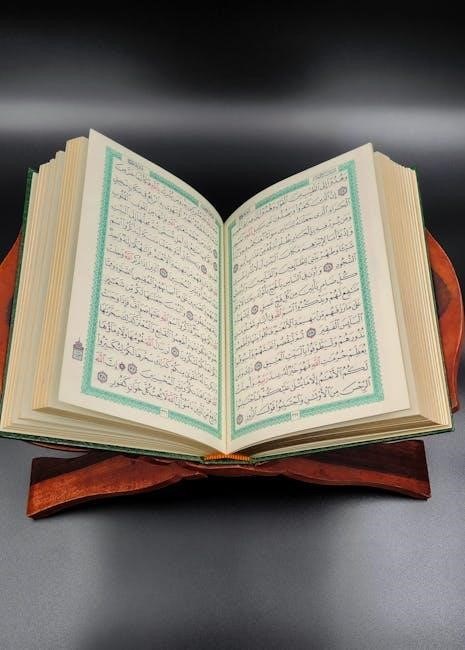studysync book grade 7 pdf
StudySync Grade 7 is a comprehensive English Language Arts curriculum designed for 7th graders, offering engaging lessons, interactive activities, and multimedia resources to enhance learning experiences.
Overview of StudySync Grade 7
StudySync Grade 7 is a comprehensive English Language Arts curriculum designed for 7th graders, offering a blend of traditional and digital learning tools. It focuses on developing reading, writing, and critical thinking skills through engaging multimedia resources and interactive activities. The curriculum is structured around four thematic units: In Pursuit, The Powers That Be, Justice Served, and Getting Along. Each unit incorporates diverse texts, including short stories, poems, and nonfiction works, to promote deeper understanding and analysis. StudySync Grade 7 aligns with educational standards, ensuring students meet key benchmarks while fostering a love for literature and effective communication. Its flexible design supports both in-class and remote learning, making it a versatile tool for educators and students alike.
Importance of Using StudySync Grade 7
StudySync Grade 7 plays a pivotal role in fostering academic growth by providing a dynamic and engaging learning experience. Its multimedia-rich content captivates students, making complex concepts more accessible and enjoyable. The program’s emphasis on reading comprehension, writing, and critical thinking skills prepares students for higher-level coursework and real-world challenges. By aligning with educational standards, StudySync ensures that students meet key benchmarks, while its interactive assignments and collaborative tools encourage active participation. Additionally, the curriculum’s thematic approach helps students connect literary works to broader societal themes, promoting deeper understanding and empathy. This holistic approach makes StudySync Grade 7 an invaluable resource for both teachers and students, supporting academic success and lifelong learning.

Curriculum and Structure
StudySync Grade 7 curriculum is structured into thematic units, providing a literature-rich, multimedia-enhanced learning experience that aligns with educational standards and fosters critical thinking.
Grade 7 ELA Curriculum Overview
The Grade 7 ELA curriculum in StudySync is designed to develop essential reading, writing, and critical thinking skills through a thematic approach. Students engage with diverse texts, including short stories, novels, and poetry, carefully selected to align with learning standards. The curriculum emphasizes the development of comprehension strategies, analytical writing, and effective communication. Multimedia elements such as videos and interactive activities supplement traditional readings, creating a dynamic learning environment. Each unit is structured to build upon previous skills, ensuring a comprehensive and progressive educational experience. This approach fosters a deeper understanding of literature and prepares students for higher-level academic challenges.
Scope and Sequence of StudySync Grade 7
The StudySync Grade 7 curriculum is organized into four thematic units: In Pursuit, The Powers That Be, Justice Served, and Getting Along. Each unit is designed to explore complex themes through diverse texts, fostering critical thinking and analytical skills. The scope and sequence ensure a logical progression of skills, with each unit building on the previous one. Students engage with a variety of genres, including short stories, poems, and nonfiction, to develop comprehension and writing abilities. Multimedia resources and interactive activities are integrated to enhance engagement and deepen understanding. The curriculum aligns with educational standards, providing a structured and comprehensive approach to English Language Arts education for seventh graders.

Key Features of StudySync Grade 7
StudySync Grade 7 offers digital resources, multimedia elements, and interactive assignments to create an engaging and comprehensive learning experience for students.
Digital Resources and Multimedia Elements
StudySync Grade 7 provides a wide range of digital resources and multimedia elements to enhance student engagement and understanding. These include interactive exercises, videos, and audio clips that bring lessons to life. The platform incorporates dynamic visuals and real-time feedback to support personalized learning. Students can access e-books, online worksheets, and virtual discussions to deepen their comprehension of texts. The integration of multimedia ensures that students can interact with content in diverse ways, making learning more immersive and effective. These resources are designed to cater to different learning styles, helping students grasp complex concepts and stay motivated throughout the academic year.
Interactive Assignments and Activities
StudySync Grade 7 offers a variety of interactive assignments and activities designed to engage students and promote deeper understanding of the curriculum. These include extended oral projects, where students write and present personal recommendations for books or movies, fostering communication skills. Additionally, skill-aligned tasks allow students to practice specific ELA skills, such as analyzing short stories or completing writing exercises. The platform also features peer discussions and collaborative activities that encourage teamwork and critical thinking. These interactive elements make learning dynamic and help students apply concepts in meaningful ways, while also aligning with educational standards to ensure comprehensive skill development.

Units Covered in StudySync Grade 7
StudySync Grade 7 includes four thematic units: In Pursuit, The Powers That Be, Justice Served, and Getting Along. Each unit focuses on specific skills and literary themes.
Unit 1: In Pursuit
Unit 1: In Pursuit focuses on themes of perseverance, courage, and identity. Students explore literary works that highlight personal and collective journeys, fostering critical thinking and empathy. Key texts include short stories and poems that prompt discussions on overcoming challenges. This unit integrates reading comprehension, writing, and analysis skills through interactive activities. A notable project involves creating a Personal Recommendation for a book or movie, enhancing communication skills. Multimedia resources, such as videos and interactive exercises, enrich the learning experience. By the end of this unit, students develop a deeper understanding of narrative structures and character development while refining their analytical writing abilities. The unit’s engaging design ensures active participation and meaningful reflection.
Unit 2: The Powers That Be
Unit 2: The Powers That Be delves into themes of authority, leadership, and justice, encouraging students to analyze how power shapes individuals and society. Through a selection of texts, including short stories and essays, students explore moral dilemmas and the consequences of authority. Key activities include analyzing character motivations and evaluating the impact of leadership decisions. Multimedia resources, such as interactive discussions and video clips, enhance understanding. A notable project involves an Extended Oral Presentation, where students present their perspectives on power dynamics. This unit strengthens critical thinking and persuasive writing skills while fostering empathy and a deeper grasp of societal structures. By examining diverse perspectives, students develop a nuanced understanding of how power operates in various contexts.
Unit 3: Justice Served
Unit 3: Justice Served focuses on themes of fairness, morality, and societal justice, inviting students to explore how justice is perceived and administered in different contexts. Through texts such as short stories and historical accounts, students examine the complexities of justice, including its emotional and ethical dimensions. Activities include analyzing characters’ moral dilemmas and participating in discussions about societal fairness. A key project involves creating a persuasive essay arguing for or against a justice-related issue. This unit strengthens students’ ability to think critically about justice and its impact on communities. By engaging with diverse perspectives, students develop a deeper understanding of the challenges and nuances of achieving justice in real-world scenarios.
Unit 4: Getting Along
Unit 4: Getting Along explores themes of relationships, communication, and conflict resolution, helping students understand the dynamics of human interactions. Through diverse texts, including stories, poems, and essays, students analyze how characters navigate friendships, family dynamics, and societal expectations. Activities focus on developing empathy and effective communication skills, with opportunities for role-playing and reflective writing. A key project involves crafting a narrative about a personal experience with conflict resolution. This unit emphasizes the importance of understanding different perspectives and fostering positive relationships. By engaging with real-world scenarios, students learn to approach challenges with empathy and resilience, preparing them for meaningful interactions in their own lives and communities.

Skill Development in StudySync Grade 7
StudySync Grade 7 enhances reading comprehension, writing, and critical thinking through interactive assignments and real-world applications, aligning with educational standards to foster advanced literacy skills.
Reading Comprehension Skills
StudySync Grade 7 emphasizes the development of robust reading comprehension skills through engaging texts and interactive activities. Students learn to analyze complex passages, identify themes, and interpret literary devices. The curriculum incorporates multimedia elements, such as audio and video clips, to deepen understanding. Interactive assignments encourage close reading and critical thinking, helping students connect ideas across texts. The program also focuses on genre-specific strategies, enabling learners to approach fiction, nonfiction, and poetry with confidence. By aligning with educational standards, StudySync ensures students build the skills necessary for advanced literacy and academic success. Regular practice and feedback reinforce comprehension abilities, preparing students for real-world applications of reading skills.
Writing and Analysis Skills

StudySync Grade 7 fosters the development of writing and analysis skills through interactive assignments and multimedia resources. Students engage in writing workshops that focus on evidence-based writing, creative expression, and analytical essays. The curriculum encourages learners to connect their writing to the texts they study, deepening their understanding of themes and characters. Activities such as the Extended Oral Project (EOP) allow students to present personal recommendations for books or movies, enhancing their communication and critical thinking abilities. By aligning with educational standards, StudySync ensures students develop the skills needed to articulate their ideas clearly and persuasively. Regular feedback and practice help refine their writing and analytical techniques, preparing them for future academic challenges.
Critical Thinking Exercises
StudySync Grade 7 incorporates a variety of critical thinking exercises designed to challenge students and deepen their understanding of texts. These exercises include analytical tasks, such as identifying themes, evaluating arguments, and solving problems within the context of the curriculum. Interactive activities, like peer-led discussions and debates, encourage students to think creatively and defend their interpretations. The program also features multimedia resources, such as videos and interactive simulations, to engage students and promote higher-order thinking. By aligning with educational standards, StudySync ensures that critical thinking skills are developed systematically, preparing students for real-world challenges and fostering intellectual curiosity. Regular practice and feedback help refine these skills, making students more confident and articulate thinkers.

Accessing StudySync Grade 7 Resources
Access StudySync Grade 7 resources by logging into the platform, where you can download the Grade 7 ELA Overview.pdf and explore interactive tools and materials.

How to Access the StudySync Grade 7 PDF
To access the StudySync Grade 7 PDF, log into the StudySync platform using your credentials. Navigate to the Library section from the main menu. Select the desired resource, such as the GRADE 7 ELA Overview.pdf, and click the download button. Ensure you have the necessary permissions and an active subscription. The PDF will be saved to your device, allowing offline access to the curriculum materials. For assistance, refer to the platform’s help section or contact support. This method ensures easy access to StudySync’s comprehensive resources, including unit overviews and skill alignments, supporting your educational journey effectively.
Navigating the StudySync Platform
Navigating the StudySync platform is straightforward and intuitive. Begin by logging in with your credentials, which will direct you to the Dashboard. From there, access the Library to explore resources like the GRADE 7 ELA Overview.pdf. Units are organized thematically, such as “In Pursuit” and “The Powers That Be,” each containing lessons, activities, and multimedia elements. Assignments and due dates are clearly listed, allowing students to track their progress. The platform also features interactive tools, such as discussion boards and multimedia resources, to enhance engagement. For additional support, utilize the help section or tutorials available within the platform to maximize your learning experience effectively.

Educational Alignment and Standards
StudySync Grade 7 aligns with educational standards, integrating IXL skills and providing a curriculum map that outlines texts and skills taught in each unit, ensuring comprehensive learning outcomes.
Alignment with Educational Standards
StudySync Grade 7 is carefully designed to align with educational standards, ensuring a comprehensive and structured learning experience. The curriculum integrates IXL skills, providing students with targeted practice to meet specific learning objectives. Each unit is built around a theme, with texts and skills taught in a logical sequence. The program adheres to state and national English Language Arts standards, focusing on reading comprehension, writing, and critical thinking. Assessments and activities are tailored to measure progress against these standards, ensuring students develop the necessary skills for academic success. This alignment makes StudySync Grade 7 a trusted resource for educators seeking to deliver high-quality, standards-based instruction.
Integration with IXL Skills
StudySync Grade 7 seamlessly integrates with IXL Skills, providing a robust learning environment that enhances both ELA instruction and skill mastery. IXL Skills are aligned with the StudySync curriculum, offering targeted practice in areas such as reading comprehension, writing, and critical thinking. This integration allows teachers to assign specific IXL exercises to reinforce concepts taught in StudySync units. Students benefit from personalized practice, while educators can track progress and identify areas where additional support is needed. The combination of StudySync’s engaging content and IXL’s skill-based practice ensures a well-rounded educational experience, preparing students for academic success and future challenges.

StudySync Grade 7 is a dynamic, comprehensive ELA program that fosters academic growth through engaging content, interactive tools, and alignment with educational standards, enriching students’ learning journeys.
Benefits of Using StudySync Grade 7
StudySync Grade 7 offers numerous benefits, including enhanced reading comprehension, improved writing skills, and critical thinking development. Its interactive and multimedia-rich resources captivate students, making learning enjoyable. The curriculum aligns with educational standards, ensuring comprehensive skill development. Flexibility in pacing and personalized learning tools cater to diverse learning styles. Additionally, StudySync fosters collaboration through virtual discussions, promoting deeper understanding. The program’s structure and engaging content prepare students for academic success, making it a valuable tool for both educators and learners.
Final Thoughts on StudySync Grade 7
StudySync Grade 7 stands out as a dynamic and effective English Language Arts program, offering a blend of traditional and digital learning tools. Its structured curriculum and engaging multimedia elements cater to modern students’ needs. The program’s alignment with educational standards ensures that students meet key learning objectives. With features like interactive assignments and critical thinking exercises, StudySync Grade 7 prepares students for academic challenges and real-world applications. Educators and students alike appreciate its flexibility and comprehensive approach, making it a valuable resource for 7th-grade education.











































































